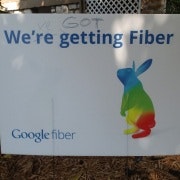Google Fiber struggles to close the digital divide

Installers for Google Fiber in northwest Kansas City, Kan., in 2013. Keith Myers/MCT/Zuma Press
When Google launched its fast internet service in Kansas City in 2012, the web giant said it wanted to spread broadband widely and close the "digital divide." But a survey conducted for The Wall Street Journal suggests the company is far from achieving that goal.
The survey, in six low-income Kansas City, Mo., neighbourhoods, found that just 10 per cent of residents subscribe to Google's Fiber service. An additional 5 per cent use a slower version that is free for seven years, after a $US300 installation fee.
By contrast, 42 per cent of the residents surveyed in five nearby middle- and higher-income neighbourhoods signed on to Google Fiber. An additional 11 per cent took the slower version. Both surveys were conducted door-to-door by research firm Haynes & Co.; the one involving middle- and higher-income neighbourhoods was commissioned by brokerage firm Sanford C. Bernstein.
The results suggest that the digital divide is less about where broadband service is offered—the subject of fierce debate when Google first arrived in Kansas City—and more about who finds it useful and can pay for it.
That points to the challenge in overcoming the divide. Nationally, 70 per cent of homes have broadband service, but only 55 per cent of African Americans and 43 per cent of households with annual income below $US25,000 have it, according to the Pew Research Center.
The two surveys by Haynes & Co. were taken on opposite sides of Troost Avenue, which has long been an economic and racial dividing line in Kansas City. The Journal survey focused on neighbourhoods east of the road, where the median household income is a little over $US20,000 and the population is 87 per cent black and 7 per cent white. The Bernstein survey polled areas west of Troost, where the median household income is just over $57,000 and the population is 63 per cent white and 21 per centblack, according to US Census data.
Google did at least as much as traditional telecom providers to encourage the adoption of Google Fiber in lower-income areas. It sent employees door to door in some neighbourhoods and teamed up with community groups to spread the word. It also supported non-profit groups that offer classes on using the Internet and sell cheap refurbished computers.
"Addressing the digital divide is going to take a lot more than any Internet offering, because some people still don't see the relevance of the Internet in their lives," said Erica Swanson, Google Fiber's head of community impact programs.
Among respondents in the Journal survey who didn't subscribe to Google Fiber, 21 per cent cited the cost—more than any other reason. The service offers speeds of one gigabit a second, about 100 times the national average, for $US70 a month; an internet and TV package costs $US120 a month. The alternative service, at five megabits a second—about half the national average—is free, but it requires a $US300 installation fee, which can be spread out over monthly $US25 payments.
"They come in here, and this is a low-income neighbourhood, and they are selling their packages at such a high rate," said Vivian Hawthrone, a resident of Squier Park, a neighborhood east of Troost Avenue, who didn't subscribe.
Other superfast Internet services come at a similar premium. AT&T charges $US70 to $US149 a month for speeds of up to one gigabit in parts of Dallas-Fort Worth and Austin, Texas. By contrast, a traditional AT&T Internet service in Kansas City, with speeds that are less than 1 per cent as fast, starts at $US19.95 a month, according to the company's website.
Researchers say such divisions are gaining importance as access to jobs, education and other opportunities increasingly comes via the internet.
"We may be limiting opportunity for poorer people because the fastest speeds are more common in richer neighborhoods," said Angela Siefer, who researched digital-divide issues this year for the University of Illinois's Center for Digital Inclusion.
For some people who don't take Google's internet service, cost wasn't the issue. Barbara Connolly, a 68-year-old resident of the Citadel neighborhood, east of Troost, has a TV, Internet and phone package from AT&T that costs more than $US250 a month. While Google Fiber's TV and Internet service is less than half the cost, she didn't want to pay an extra bill for a phone line.
She was also confused by Google's slower internet service, and the $US300 upfront installation fee. "I didn't understand the whole concept, and Google explained nothing to me," she added.
The cheaper service isn't attractive to many poorer Kansas City residents because they rent their homes and move regularly, according to Rick Chambers, head of an education foundation in the area. The service is attached to the property, so if residents move, they can't take it with them, he said.
The Journal survey found other reasons for the low adoption of Google Fiber. Some residents said they didn't need faster service because they don't use the Internet much. Others said the Internet service on their smartphones is adequate.
"The Internet is not really important," said Chad Grade, a 24-year-old single father and factory worker who lives in Vineyard Northwest, another area east of Troost. "I use it for navigation on my phone, but I don't use it at home."
Such statements trouble John Horrigan, a consultant who studied broadband adoption at the Pew Research Center and for Comcast Corp "School work, searching for a job and some health-care applications are much less useful for people with only a smartphone's small screen as their connectivity device," he said.













